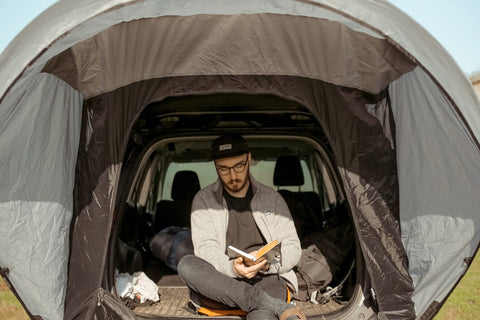Why do we camp? We don’t go into the wilderness to find comfort, and we don’t seek out the unknown to be familiar with our surroundings. So we’re left with an immeasurable amount of wonder as to why we chase exploration.
We see this trend of traveling canvassed over our social media channels; a group of young adults in a picturesque setting sharing a fire and fresh brewed coffee at sunrise. Without discrediting the occasions on which this scenario actually happens, this is meant to explain how camping doesn’t always look like that, and that’s okay.

If you’re fortunate enough to live in a paradise with a group of friends who are never preoccupied in their work or classes and have an unlimited amount of gear, then none of this may apply to you. This is for those attempting to juggle all aspects of their lives, and pursue their passion for the outdoors simultaneously. I happen to fall into the latter category, and by having a full-time job for the past year along with freelancing on the side, I’ve felt the strain it can have on my passion for traveling.
Whenever you are faced with a free weekend, or even a few hours of freedom, you have an option; stay or go. You can relax inside, or go out and try something new. That internal voice has to be strong enough to discredit any obstacles in your way (bad weather, lack of gear, lack of friends to be with). If you want to go, not for your friends and not for social media but for your own sense of adventure, then nothing can stop you. But it has to push through all of the doubt.
This doubt can be boiled down to a few factors. For myself, it was the gear I owned, the conditions of where I’d be staying, and how many friends could join. There’s an important thing to note about these elements; none of them matter.
Nature doesn’t care what brand name is on your backpack or which water bottle you carry, as long as it gets you where you’re going that’s all that matters. Nature also doesn’t care how many people are in your party. It doesn’t function solely for our own benefit, but rather we go into nature to appreciate and respect it. As for weather, as long as you are sensible and cautious, a little rain shouldn’t deter you from pitching a tent.
The purpose of all this isn’t meant to boost your morale and send you on your way. There is some tangibility to these ideas, and here are some factors to keep in mind:
- The brand of your gear doesn’t matter. You could get it from a thrift store or the top of the line, but as long as it functions, you can be on your way.
- The list of gear is flexible. Not everyone needs an AeroPress or hammock. As long as you can find a place to sleep with some form of shelter, you’re covered. (The photo below is an illustration of the gear I bring with me on solo trips.)
- Your budget is irrelevant. An annual pass to every National Park is a measly $80, and campsites range anywhere from $15+ a night. Food for one is as cheap or expensive as you make it, and gas is at an all time low price in several regions. Putting it into relevant terms, you could see all 417 National Parks for the same price as 16 cups of coffee. You could spend a night camping in one for 3 cups. (Take that into consideration next time you hear someone groaning on about entry or camping fees.)
- Location and time are irrelevant. There are fantastic sights to see across the country, regardless of where you are or how much time you have available to see them. As long as you have a well thought out travel itinerary, budgeting time will allow you to maximize your time spent on exploring and minimize your time spent on commuting.

